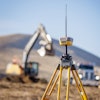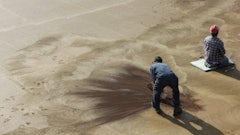How do you construct a foundation for an 80-year-old church located on a tight hillside lot with minimal disturbance of the surrounding fragile soil conditions?
Precision Pier USA, Inc. was asked to deliver a workable solution when Austin/Jones Corp. received the general contract to restore the historic Saint Catherine of Sienna Church of Laguna Beach, Calif.
The 80-year-old structure with 48-ft.-high bell tower has not only served the parishioners since the 1920s, but also served sailors traveling the Pacific coastline as a recognizable landmark. It has been such a visible part of the Laguna Beach community for so long, finding its way on many an artist’s canvass, that the governing dioceses felt obligated to preserve this architectural gem.
The $4 million reconstruction began in November 2003 and will be completed this fall.
Ken Fitz, project superintendent, says excavating below the tower to accommodate a new foundation wall for the front of the main church structure, as well as build a lower level lobby entrance (beneath the tower) represents a significant portion of the reconstruction project – both in dollars and challenges. Keeping the tower in place during construction is no small feat in itself, but to also build a new foundation for the church, which over time has started to move down the hill, has proved to be equally as difficult.
The foundation solution being used on the project is similar to the technique used to construct piers along a waterfront. After driving 2-in. pipe vertically into the soil every 4 ft. to form the footprint of the foundation wall, 3 1/2- in. helix pipes are then corkscrewed at a 30-degree angle back into the hillside as a way to secure the foundation pipes. Three rows of tiebacks were used on each vertical pipe, with the top helix pipe driven 35 to 40 ft. into the hillside, the middle helix driven 25 to 30 ft. into the hillside, and the bottom helix tieback driven 20 ft. into the hillside.
In between the vertical pipes and the hillside, a drainage filter material and welded wire mesh are placed to form the backside of the foundation wall before the helix tiebacks are tightened into position to hold the hillside in place. Standard concrete forms were then used for the front side of the foundation wall.
“The zero-clearance (foundation) wall system really proved to be the best solution for this project,” Fitz says. “We’ve used the Helix Pier system on another project Precision Pier helped us with and it really worked well. After the concrete is poured, the mesh, vertical pipes and Helix tiebacks are all tied together, and it really makes for a good foundation. The other advantage is that we didn’t have to disturb the surrounding soil in order to install the system.”
For more information, contact Precision Pier USA, Inc. at (530) 525-4560 or visit www.precisionpier.com.
Greg Udelhofen is the editor of Asphalt Contractor, a sister publication of Concrete Concepts, and frequently writes about the concrete and construction industries. He can be reached at [email protected].














![Fcp Racatac Chair 10893876[1]](https://img.forconstructionpros.com/mindful/acbm/workspaces/default/uploads/2025/10/fcp-racatac-chair-108938761.10l0At5WXv.png?ar=16%3A9&auto=format%2Ccompress&bg=fff&fill-color=fff&fit=fill&h=135&q=70&w=240)



